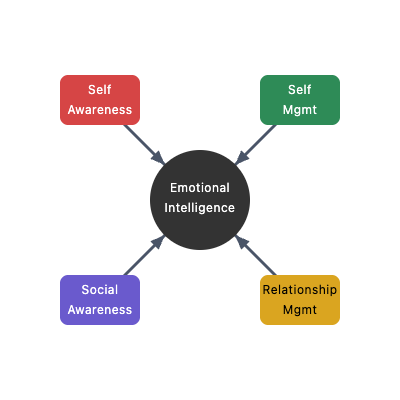Welcome to Manage Emotions in Communication. In this course, you’ll learn practical ways to stay calm under pressure, read others’ emotions, and turn tense conversations into productive ones.
Emotions affect everyone around us. When you manage your emotions well, you help your team handle tough situations, reduce conflict, and make communication smoother for everyone.
You’ll cover four main areas: how emotions affect communication, how to keep your cool, how to handle group emotions, and how to use empathy to improve conversations. Each lesson gives you tools you can use right away.
Emotional intelligence means seeing emotions as useful information, not just reactions. For example, if you feel frustrated in a meeting, that feeling tells you something important—maybe a value was challenged or an expectation wasn’t met. The key is to notice your emotions without letting them take over.
Emotional intelligence has four parts:

- Self-awareness: Noticing your own emotions as they happen.
- Self-management: Choosing how to respond instead of reacting automatically.
- Social awareness: Picking up on how others are feeling.
- Relationship management: Handling emotional situations with others in a positive way.
You can improve emotional intelligence with practice. Every conversation is a chance to get better at noticing and managing emotions—both your own and others’.
Emotions spread quickly in groups—this is called emotional contagion. If one person is anxious, others start to feel it too. If someone is calm and positive, that mood can lift the whole group.
For example, if a team leader gets frustrated during a meeting, others might shut down and stop sharing ideas. But if the leader stays calm and curious, the group feels safer and more willing to participate.
Here’s how emotional contagion might play out in a typical team meeting:
- Jessica: "This is a disaster! We're never going to meet the deadline with all these changes."
- Ryan: "You're right, this is impossible. I don't even know where to start anymore."
- Jessica: "Everything's falling apart. Maybe we should just tell them we can't do it."
- Victoria: "I hear the frustration—these changes are significant. Let's take a breath and break this down piece by piece. What's the most critical part we need to address first?"
- Ryan: "Well... I guess the database updates are the foundation for everything else."
- Victoria: "Good. That gives us a starting point. Jessica, what would you need to tackle that section effectively?"
Positive emotions can build momentum and help teams work better together. Negative emotions can drag everyone down. By managing your own emotions, you can help set a better tone for the group.
Personal triggers are things that set off strong emotions in you—like being interrupted, getting vague feedback, or seeing someone take credit for your work. These triggers can make it hard to communicate clearly.
Start by noticing what situations or words trigger you. For example, do you get defensive when someone questions your ideas? Do you get irritated when meetings run late? Write these down so you can spot patterns.
Once you know your triggers, plan how you’ll respond. If interruptions bother you, try saying, "Let me finish my thought, then I’d like to hear yours." If vague feedback frustrates you, ask, "Can you give me a specific example?"
The goal isn’t to stop feeling emotions, but to give yourself a moment to choose your response. With practice, you’ll get better at using your emotions as helpful information instead of letting them take over.
In the next exercises, you’ll identify your own triggers and practice ways to manage them. This self-awareness is the foundation for all the skills you’ll build in this course.
